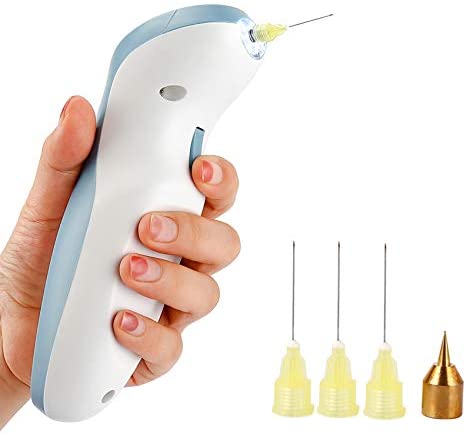Plasma Pen Fibroblast Therapy
Are you considering plasma pen fibroblast therapy? If so, keep reading. We all know that skin conditions can range from mild to severe, and while you might be able to manage using over-the-counter treatments, other skin issues may require medical attention.
Plasma pen fibroblast therapy is one technique that has been found to work well for many patients with chronic skin conditions and can be administered without a doctor’s visit. What does this mean for the future of dermatology?
The treatment is non-invasive and involves placing a pen tip at the skin’s surface. The plasma gas then penetrates below the skin to stimulate collagen production for smoother and more radiant skin.

What exactly is Plasma pen fibroblast therapy?
The plasma pen is a device that uses high-frequency electric pulses to deliver fibroblast cells to the skin. A plasma pen is a device that generates an electric current that is used to activate and distribute the fibroblast cells in the treatment area.
Research studies on this new therapy show promising results so far, with improved skin texture, clinical signs of facial redness caused by microscopic blood vessels, and the appearance of fine wrinkles being reduced.
What Are Plasma Pens?
Plasma pens are pen-like devices with two electrodes used to generate a beam of high-temperature, ionized gas at the tip of this pen. This beam or jet of gas can be applied to the skin to destroy abnormal tissue for patients with various skin conditions.
Painful procedures such as laser therapy or surgery may not be necessary when using plasma pen fibroblast therapy because it only needs to be applied once, and then you’re done. It also leaves no scars, so there’s no need for bandages afterward.
What are fibroblasts?
Fibroblasts are cells that produce collagen, the connective tissue found in your skin. Collagen is an essential part of our skin’s structure and function, including its ability to repair itself. However, younger people have more active fibroblasts, meaning their skin has more of this vital protein.
Plasma Pen Fibroblast Therapy uses a patented ultrasonic frequency that helps your fibroblasts produce more elastin and collagen, making your skin healthier.
Treatment areas for plasma pen?
It can heat joints and muscles or promote the healing of wounds such as burns and stretch marks. The pen is also an excellent device to use on scars that are red, raised, or have discolored edges.
The plasma pen shoots a charged plasma beam at the skin and can also be used to treat various skin ailments such as acne, uneven skin tone and pigmentation, rashes, age spots, and scars.
The treatment is beneficial for people who have had surgical procedures such as open-heart surgery, knee, and hip replacement surgery, or tumor removal.
Do doctors recommend plasma pen fibroblast?
The word “fibroblast” may sound unfamiliar. A fibroblast is a cell that synthesizes collagen and other connective tissues in medicine. These cells are named for the Latin word “fibra,” which means fiber.
Collagen is one of the most abundant proteins in the human body, and it’s found in all muscles, bones, and skin. If your doctor has prescribed this treatment, they believe that an imbalance in these cells causes your condition.
How long to see results from pen fibroblast therapy?
There is no definite answer to how long it takes to see results from using plasma pen fibroblast therapy. Some people can see a significant difference in three months, and others might need up to twelve months before noticing any improvement.
The treatment outcome can differ from patient to patient and depends on various factors, including the severity, location, and duration of the injury. The majority of patients see improvement within three months after a session.
After a few treatments, you’ll want to see improvement for the best results. Treatment sessions are spaced out to allow your skin to heal in between sessions.
This will help give the treatment more of an impact by allowing your skin to build new collagen and elastin, making it firmer and healthier.
Is plasma pen fibroblast therapy painful?
Although some patients might experience mild discomfort during the procedure, it is often easy to handle. That’s because the treatments are carried out at a very low temperature. You might feel a tingling sensation or a slight heating sensation in some cases.
Many people are hesitant to try this treatment because they think it’s going to be painful. But that isn’t the case. It’s a relatively painless procedure, and you can use a topical anesthetic for any discomfort.
What is the recovery time for plasma pen fibroblast therapy?
Most patients can resume normal activities the same day of their treatment and return to work immediately. The treatment doesn’t have any side effects.
There is no recovery time for this procedure. Any discomfort associated with the treatment will dissipate after a few hours, but you can take painkillers to control any pain.
Are there any side effects from plasma pen fibroblast therapy?
One of the benefits of plasma pen fibroblast therapy is that it does not require general anesthesia. However, some possible side effects such as pain and bruising can happen in the first few weeks after treatment.
There are usually no side effects when using plasma pen fibroblast therapy for most people. However, there is a chance of irritation at the application site or temporary redness.
Overall, it’s a good alternative for people who don’t want surgery or drugs to help relieve their symptoms.
Final thoughts
Plasma pen fibroblast therapy, as noted before, is a new treatment for skin imperfections. It’s not as expensive as other treatments, and it doesn’t necessarily require a doctor.
It works by using an electric current to activate cells in the skin. This reaction encourages collagen production, which in turn renews the skin. The most noticeable benefits are that it can even out skin tone and reduce wrinkles on the face.
It is also known to produce anti-inflammatory effects and help increase blood flow in wounds.
Before deciding if plasma pen fibroblast therapy is right for you, it’s best to talk to your doctor or your skin care provider to see if this is the best option for you.

